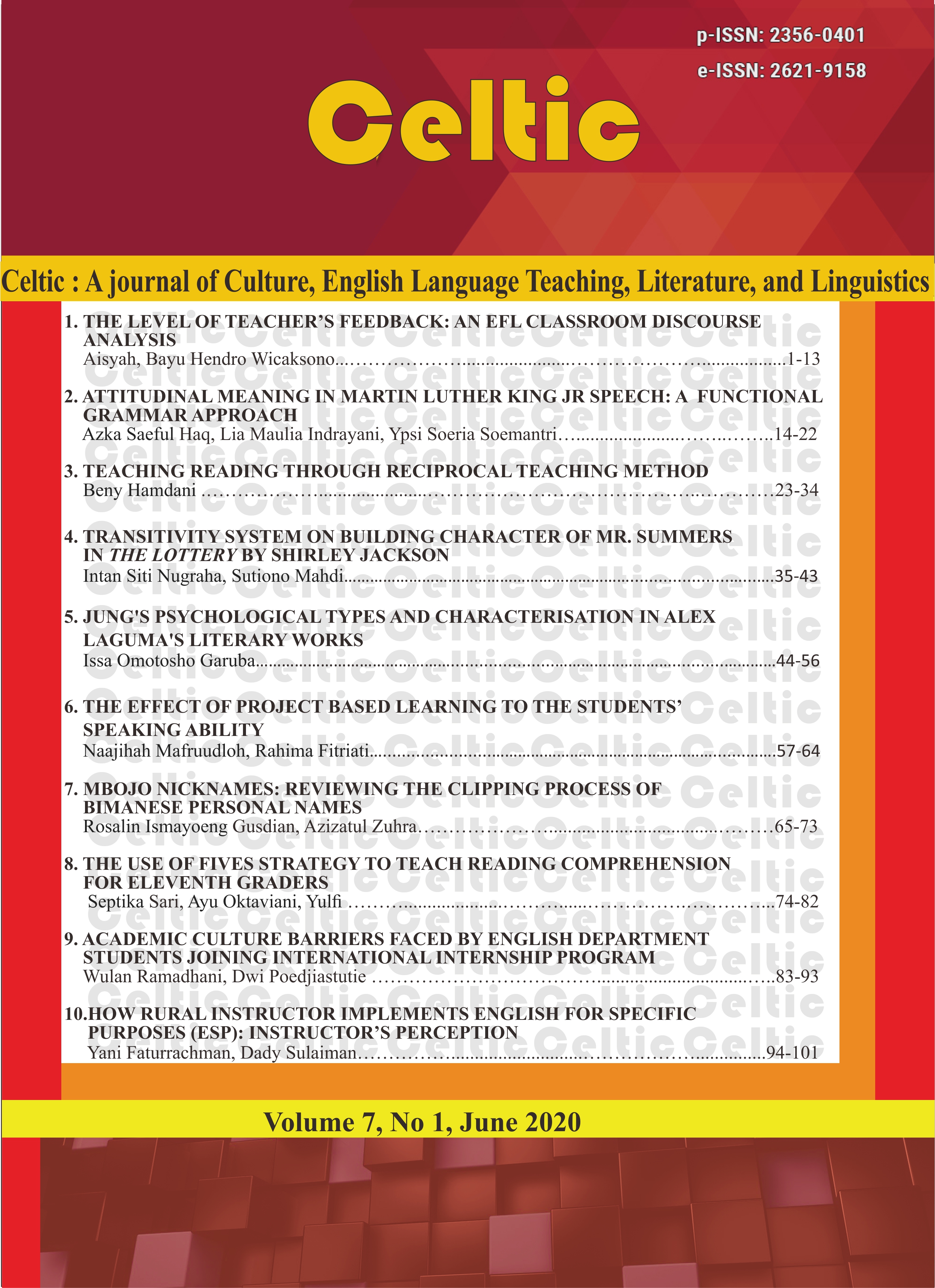THE LEVEL OF TEACHER'S FEEDBACK IN ENGLISH TEACHING: AN EFL CLASSROOM DISCOURSE ANALYSIS
DOI:
https://doi.org/10.22219/celtic.v7i1.12237Keywords:
EFL Classroom, EFL Teacher, The Level of Teacher’s FeedbackAbstract
The objectives of this research are to know the level of feedback applied by the EFL teacher at a junior high school in speaking class and to know the most frequent level of feedback employed by the EFL teacher. Moreover, this research conducts a qualitative research where the data of this research are the English teacher’s utterances when the teacher taught speaking for VII grade students at one of state junior high school at Sentani, Papua. Meanwhile, the data was gathered through observing and transcribing the video of English teaching and learning process. The analysis of the transcript revealed that: (1) there arethree levels of feedbacks employed by the teacher: feedback of task (6.25%), feedback of process (37.5%), and feedback of self as a person (56.25%) and (2) the most frequent level of feedback employed by the teacher is the feedback of self as a person since it gathered 56.25% during the teaching and learning activity. Based on the result of this study, it can be concluded that teacher’s feedback is an important tool to facilitate the learning process become more active. Therefore, It is suggested the teacher may use more collaboration of feedback toward students’ response or performance in the learning process.
Downloads
References
Adel, A. (2018). Remember That Your Reader Cannot Read Your Mind. Problem/Solution-Oriented Metadiscorse in Teacher Feedback on Student Writing. Retrieved from: https://www.reserachgate.net/publication/309184970.
Aisyah & Wicaksono, B.H. (2018). Pre-Service Teachers' Belief on Professional Development: A study on ESP Teacher. CELTIC: A Journal of Culture, English Language Teaching, Literature & Linguistics. 5(2), 8-17.
Al-Bashir, M., Kabir, R., & Rahman, I. (2016). The Value and Effectiveness of Feedback in Improving Students’ Learning and Professionalizing Teaching in Higher Education. Journal of Education and Practice. 7(16), 38-41.
Brooks, C., Carroll, A., Gillies, R. M., & Hattie, J. (2019). A Matrix of Feedback for Learning. Australian Journal of Teacher Education. 44(4), 14-32.
Erkkila, M. (2013). Teacher Written Feedback: Teachers’ Perceptions of Given Feedback. Department of Languages English, University of Jyväskylä. p.16
Ferguson, P. (2011). Student perceptions of quality feedback in teacher education. Assessment & Evaluation in Higher Education, 36(1), 51-62.
Ferris, D. R., & Hedgcock, J. S. (2005). Teaching ESL Composition: Purpose, process, and practice. Mahwah, NJ: Lawrence Erlbaum Associates.
Harmer, J. (2002). The practice of English Language Teaching: 3rd edition. Malaysia: Longman.
Hattie, J. (2012). Visible Learning for teachers: Maximizing impact on learning Retrieved from: http://uq.summon.serialssolutions.com/link/0/eLvHCXMwY2BQMDMzMQUdeGqZamaQZGaZZmKWlGpqZmGZbJ4KuoEjDWWsA6k0dxNlkHZzDXH20C0tjIeOXsQ nGQOb_MBKssJQjIE3EbTqO68EvDssBQAB8xqS
Hattie, J., Gan, M., & Brooks, C. (2017). Instruction based on feedback. In R. E. Mayer & P. A. Alexander (Eds.), Handbook of research on learning and instruction (2nd ed., pp. 290-324). London, England: Routledge.
Hattie, J & Timperley, H. (2007). The Power of Feedback. Review of Educational Research. University of Auckland.77(1), 81-112.
Hunt, G.H., Wiseman, D.G., & Touzel, T.J. (2009). Effective Teaching: Preparation and Implementation. Illinois: Charles C Thomas Publisher.
Irwin, B. (2017). Written Corrective Feedback: Student Preferences and Teacher Feedback Practices. IAFOR Journal of Language Learning. 3(2). 35-58.
Mollestam, E & Hu, L. (2016). Corrective Feedback on L2 Students’ Writing. Malmo Hongskola. p.22
Noor, N M et al. (2010). Teacher’s verbal Feedback on Students’ Response: A Malaysian ESL Classroom Discourse Analysis. School of Language and Linguistics. Faculty of Social Science and Humanities. University Kebangsaan Malaysia. Malaysia.
Nurmiati. (2017). Teacher’s Corrective Feedback Strategies on Students’ Speaking Performance and Students’ Perception Toward Corrective Feedback. Universitas Tanjungpura Pontianak.
Panhoon, S & Wongwanich, S. (2014). An Analysis of Teacher Feedback for Improving Teaching Quality in Primary Schools. Procedia - Social and Behavioral Sciences. 116. 4124 – 4130.
Voermon, L et al. (2012). Types and Frequencies of Feedback Interventions in Classroom Interaction in Secondary Education. Centre for Teaching and Learning. Utrecht University. The Netherlands.
Wen, Y. (2013). “Teacher Written Feedback on L2 Student Writings”. Journal of Language Teaching and Research. Finland: Academy Publisher.4(2), 428-429.
Wiliam, D. (2011). Embedded Formative Assessment. Bloomington, IN: Solution Tree Press.
Zhan, L. (2016). Written Teacher Feedback: Student Perceptions, Teacher Perceptions, and Actual Teacher Performance. English Language Teaching. 9(8), 73-84.
Downloads
Published
How to Cite
Issue
Section
License
- Authors retain copyright to publish without restrictions and grant the journal right of first publication with the work simultaneously licensed under a Creative Commons Attribution License that allows others to share the work with an acknowledgement of the work's authorship and initial publication in this journal.
- Authors are able to enter into separate, additional contractual arrangements for the non-exclusive distribution of the journal's published version of the work (e.g., post it to an institutional repository or publish it in a book), with an acknowledgement of its initial publication in this journal.
- Authors are permitted and encouraged to post their work online (e.g., in institutional repositories or on their website) prior to and during the submission process, as it can lead to productive exchanges, as well as earlier and greater citation of published work.














